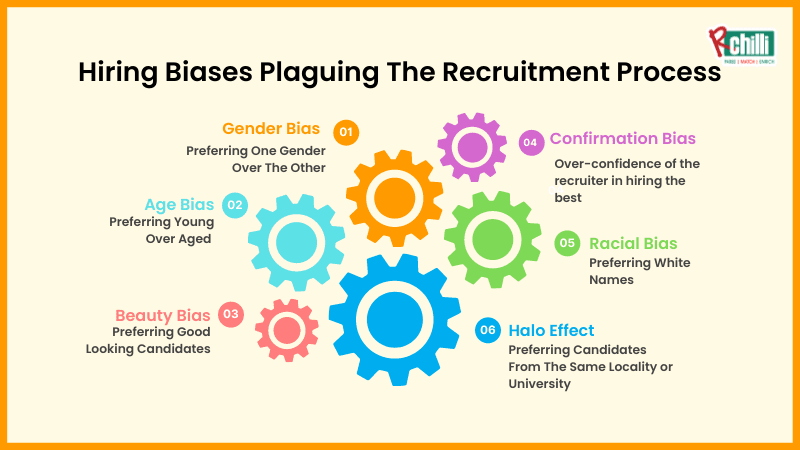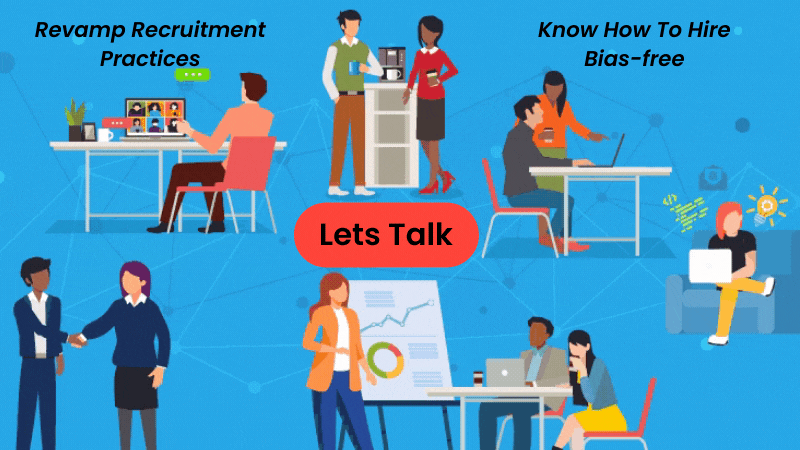“I trust my gut when screening resumes and recruiting candidates. If something doesn’t feel right, I just move over to the next resume”, quotes Bella, who’s been recruiting for almost five years now. While the “logical” explanation can be a great piece of advice for the mundane chores of the day, it can do more harm than good to a business, if followed when seeking a talented and skilled candidate.
Depending on instincts is where the hiring managers and recruiters can go wrong. For those who’ve experienced unsuccessful recruitments in the past and are still struggling, you may be overseeing how the recruitment practices are plagued by unconscious bias. To reduce the impact, it’s important you first know
- The types of unconscious biases,
- How it slithers its way into our recruitment approach,
- And finally, what can be done to overcome it.
What are the common yet unknown categories an unconscious bias can be segregated into?

Read more about a detailed analysis of each here.
Moving on, the next fact to think upon is how do you introduce these biases despite trying your level best to hire only the talented professionals. Knowingly or unknowingly, hiring bias can find its way into your recruitment process. Let’s understand how this happens:
-
When Prejudice Takes Over Rationale
This one’s quite common. One often lets his/her preference for a particular profile reject certain candidates, regardless of their qualifications or skills. When recruiting, one should be receptive toward a more diverse team that goes beyond the “I think” perspective.
There can be many reasons to substantiate the prejudice. Perhaps, one believes that a particular candidate worthy of a post should have a certain level of education or experience. Other than this, the need to be from a specific location or country too can contribute to overlooking the resume.
While there’s no denying that having local knowledge is important for a certain profile, it should not be the only reason for the selection. Instead, an intelligent recruiter will consider hiring a professional who brings a fresh perspective of serving in a different country and diversifies the talent pool.
-
When Comparison and Similarity Takes Over
During the resume screening or interviewing a candidate, how often have you thought, “They remind me of myself” or “we have a lot in common”?
This falls under the affinity bias category and is one of the most common hiring biases. Usually, we prefer those who either belong to the same gender, or race, talk in the same dialect, or belong to a similar background.
Quite difficult to break, putting these biases aside, asking for self-discipline, and following the objective approach towards reducing bias, can help you recruit better.
-
When Identities Are Mixed Up With Competence
What’s the first thing you notice in a candidate during resume screening? For most, the answer would be the photo. We often presume that a particular candidate is a good fit for the job by their looks, and for many- a photo alone can be a deciding factor.
During an interview, an assertive female is often termed as being too forceful, while her male counterpart with the same quality will be considered to have strong leadership skills. Most recruiters don’t understand that these qualities don’t reflect their potential as an employee.
Since these impressions are engraved in our mindsets from a young age, we tend to relate to them in our day-to-day lives. Nevertheless, automating recruitment is the solution to avoid falling into the traps and bring a positive change in the hiring practices.
How RChilli’s Data-Field Extraction Feature in Oracle HCM Helps Combat Bias?
RChilli resume parser + Oracle HCM Cloud Profile Import Plugin help the recruiters remove bias early in the first step, i.e., resume screening. Helping the recruiters build a diverse talent pool, the ingenious Oracle HCM plugin powered by deep learning enhances the ability of the recruiters to make an objective-based candidate selection.
RChilli resume parser for Oracle HCM helps the recruiters hire only the skilled candidates by enabling them to select from the resume data fields like skills, certifications, education, experience, and more. Biased hiring can be a thing of the past. The parser fetches and auto-populates nearly 140+ resume data fields, apart from the 27+ fields promoted by Oracle HCM, and shares a database of candidates who match the selection criterion.
The resume parser for Oracle Recruiting Cloud encourages blind recruiting. This means a recruiter gets to build a workforce that’s selected without any biases like gender, age, color, or the ones mentioned above. Hence, the hiring is fair, diverse, and quality centric.
Remember the first trap I spoke about- RChilli’s CV parsing in the Oracle HCM tool caters to the prejudice by helping the recruiters hire skilled candidates from anywhere across the globe. With the ability to parse resumes in 25+ languages along with the data field selection, you can be assured of getting accurately parsed data of a skilled and a global candidate who fits your selection criteria.
Reach Your Potential Candidate By Eradicating The Hiring Bias
Hiring bias poses a significant threat to your company’s talent acquisition process, and ironically, it isn’t going away too. However, automating the hiring process can help you hire the best people and build a diversely qualified team.


